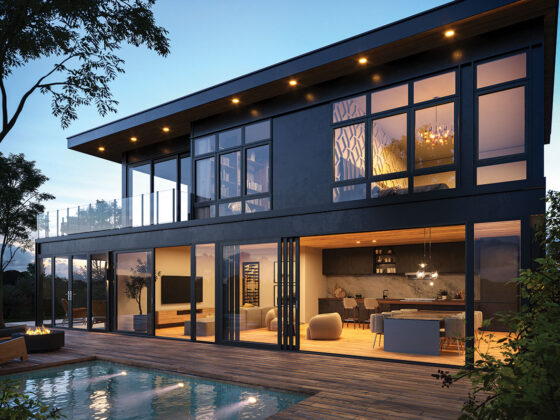
Changing style trends reflect a longing for peacefulness.
Story by Tracy Dickinson
Featured in January/February 2021
The new year always brings hope for change: the promise of a new fitness program, the anticipation of new habits, or just the end of the year behind us. Designers say style changes for 2021 lean toward softer, natural influences as homeowners look to incorporate a sense of calm and peacefulness in a chaotic time.
Color
Neutral tones continue to dominate the market, but strong grays are beginning to soften.
“We’re seeing grays that tend toward the ‘greige’ combined with soft whites instead of the strong grays and whites we’d been seeing,” says Deb Pudenz of Wild Rose Interiors. “Homeowners seem to be looking for softer earth tones.”
Meredith Beattie of Interior Design Group/Trieste says, “Grays are still popular but more as an accent color blended with warmer tones of browns, taupe, and neutrals.” She says mauve, hunter green, and teal remain hot for adding striking accents to these neutral shades.
“As with most trends,” says Pudenz, “things take a little longer to change in the Midwest. The huge popularity of gray has already dropped significantly in places like New York and California.”
“Sherwin Williams’ 2021 paint color of the year is called Urbane Bronze,” says Beattie. “It’s a natural earth tone gray/brown, which reflects the softer, neutral shades homeowners are wanting.”
Wood
Another way professionals are softening their designs is through the use of woods and natural materials.
“I’m seeing a lot of light maple,” Beattie says. “Exposed-wood chairs and wood-framed furniture pieces are showing up more often instead of fully upholstered pieces.”
“Lighter wood tones are definitely the trend. And designs are incorporating wood accents throughout the space with open shelving, wood range hoods, even stained-wood islands with painted perimeter cabinetry,” Pudenz says. Using those natural finishes as accents adds texture, contrast, and warmth to a room without dominating the design.
“A trend I’m seeing in flooring is making a pattern out of the wood floors. Whether it’s a herringbone pattern or basket weave pattern, this technique adds interest and defines a space without having to add an area rug.”
Meredith Beattie, Interior Design Group/Trieste
She says that although the lighter finishes are most common, especially in new construction, that’s not always the case with remodels. “Homeowners who have existing oak trim throughout the home need something that balances with that. Most people don’t want to replace all the trim in the house, and those midtones or walnut-look finishes are often a good option in these situations.”
Opting for wood or wood-look flooring is by far the dominant choice for homeowners.
“Whether it’s natural or engineered, hardwood is still the preference for many clients,” Pudenz says. “But luxury vinyl tile (LVT) and luxury vinyl plank (LVP) products are really growing. The quality of these products is impressive.”
Those products do not offer significant cost savings up front over traditional hardwoods. But the lower maintenance over their lifespan makes them a valuable investment.
Beattie adds that luxury vinyl flooring is especially popular in certain areas of the home, such as the kitchen and high-traffic areas. Hardwoods are still the material of choice for many clients, however. “A trend I’m seeing in flooring is making a pattern out of the wood floors,” she says. “Whether it’s a herringbone pattern or basket weave pattern, this technique adds interest and defines a space without having to add an area rug.”
Textures
To add more warmth to the home, designers are mixing colors, fabrics, finishes, and materials.
“Clients still like whites for kitchen cabinets, but I’ve seen warm gray stains and natural-wood stains coming back,” says Beattie. “In powder rooms and laundry rooms, homeowners are willing to go with more color—green, teal, or even black.”
In addition to large-scale area rugs, living spaces benefit from multiple textures in furnishings, too.
“Most homeowners are leaning away from full matched sets of furniture,” Pudenz says. “Leather is more often an accent—like an ottoman or side chair—rather than the couch and love seat set.” She adds that improvements in performance fabrics have made it possible for homeowners to choose the softer, lighter colors they prefer without worrying about damage.
“Performance fabrics used to feel like rough, outdoor materials, but the new Crypton and other performance materials are so soft and available in a huge variety of patterns, styles, and colors. It makes it possible to go with lighter colors because you don’t have to be concerned about stains.”
Beattie says, “I’m seeing a lot of very soft, comfortable fabrics, even things like Sherpa and faux furs on accent chairs and pillows. I’m using Crypton fabrics on everything from sofas to dining chairs and counter stools.”
Even metals are adding to the eclectic finishes in decor this year. “It seems like all the rules have gone out the window,” Pudenz says. “No one ever used to mix metals, but we see that a lot now—polished or brushed nickel with black, matte black with antique brass.”
“I don’t follow the rule of keeping all the metal finishes the same either,” says Beattie. “I like to mix metals and incorporate other materials like acrylic and wood into the space.”
All of these trends lend themselves well to the modern farmhouse style that remains popular, especially here in the Midwest. But both Pudenz and Beattie say that, too, is softening.
“I love to pair antiques with something modern to give a space an unexpected look,” Beattie says. “And I wouldn’t be surprised to see more modern or eclectic styles merging with the modern farmhouse style.”
“That farmhouse trend is waning a bit, but the things people love about it are just being incorporated in new ways. So the style isn’t completely going away. We’re using those classic farmhouse elements in new variations, like shiplap installed vertically instead of horizontally,” Pudenz says.
Everyone may be ready for a change of scenery at this point, but what homeowners are really longing for is to make their house feel like home even if it has to serve as an office and schoolroom, too. •
Resources
- Meredith Beattie Interior Design Group/Trieste
- Deb Pudenz Wild Rose Interiors








